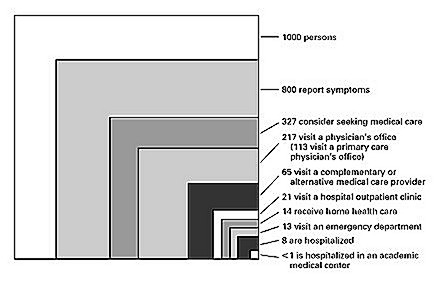
Am Fam Physician. 2001;64(6):928
More women, men and children receive medical care each month in the offices of primary care physicians than any other professional setting. There is an urgent need for health policies that encourage further innovation and implementation of first-rate primary care for everyone.
For beleaguered primary care physicians wondering about their role and place in a chaotic non-system of health care that makes their work difficult, if not impossible, the current ecology of medical care makes clear that they are highly important. More than 12 times as many people are seen in primary care physicians' offices as in hospitals. Thus, the design and implementation of first-rate primary care in the United States is a critical focus needing urgent attention by governments, professional societies, business executives, health payment systems, policy analysts and voluntary organizations.
Since its publication in 1961,“The Ecology of Medical Care” by White, Williams and Greenberg (N Engl J Med 1961;265:885–92) has provided a framework for thinking about the organization of health care, medical education and research. This landmark analysis focused on two questions: Is new knowledge fostered by immense public investment in medical research being delivered effectively to the consumers? Is the available quantity, quality and distribution of contemporary medical care the best it can be from the consumer's perspective? These questions remain strikingly relevant today.
Using contemporary data from the United States, the ecology of medical care has been updated to show where the people of the United States are getting health care in a typical month (N Engl J Med 2001;344:2021–5).
This figure includes children and reconfirms that most of the problems most people have most of the time would escape detection, analysis and response by health care efforts restricted to hospitals and academic health centers.

An overemphasis on any one level of care will neglect issues of great importance. A balanced approach is necessary for adequate health policies. The need for balance applies to current policy issues such as medical errors, government appropriations for research, the focus of education for physicians and nurses the implementation of medical information systems, and the relative allocation of resources to public and personal health care.
Despite substantial changes in the organization and financing of health care in the United States, this updated medical ecology shows that the estimated monthly use of health care services in the United States has remained remarkably consistent over the past 40 years. The bulk of the health care enterprise remains in primary care, self-care and ambulatory care.